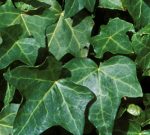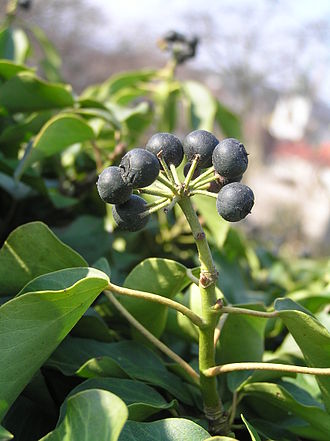
This evergreen climbing vine is a member of the Aralia family, Araliaceae, that also includes Fatsia and Schefflera and is native to most of Europe and western Asia where it grows in waste spaces and on walls and tree trunks. It was brought to the US as an ornamental in colonial times and since then has escaped from gardens and naturalized in many areas of the East, Midwest and Pacific Coast. In some areas it is considered a noxious weed or invasive as it smothers the natural vegetation. In addition, it may harbor unwanted life, and cause structural damage to stucco, wood, brick mortar, gutters and aluminum siding. Photo Credit Wikipedia

Description: Growing up to 98’ long, this vine produces aerial rootlets with matted pads that cling tightly to various surfaces. The dark green leaves are waxy and have conspicuous white veins. Young leaves are palmately five-lobed while older leaves on flowering stems in full sun are unlobed and cordate. Small greenish-yellow flowers are produced on mature plants in umbels up to 2” wide from late summer to late fall and are followed by .3” wide black-purple fruits attractive to wildlife.
Poisonous Properties: All parts of the plant contain toxic, irritant and allergenic compounds. The leaves have the highest concentration with the berries next. The main compound associated with toxicity are triterpene saponins (hederasaponins A and B) that form saponin glycosides, hederins. Contact with the cell sap (usually by pruning) can produce severe dermatitis with blistering and inflammation, while the ingestion of the berries can result in a burning sensation in the throat, vomiting, diarrhea, labored breathing, convulsions and coma. Extreme problems, however, are rare. The consumption of large amounts of the leaves by livestock can lead to vomiting, diarrhea, spasms, staggering, and paralysis, but the victims usually recover. Photo Credit Petr Filippov Wikimedia Commons